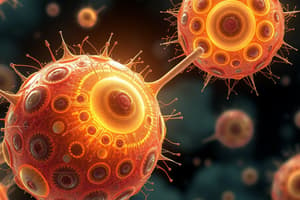Podcast
Questions and Answers
What is the primary method of reproduction in prokaryotes?
What is the primary method of reproduction in prokaryotes?
- Binary fission (correct)
- Sexual reproduction
- Spore formation
- Budding
Which of the following is not a characteristic of binary fission in prokaryotes?
Which of the following is not a characteristic of binary fission in prokaryotes?
- Produces two genetically identical daughter cells
- Results in a change in the number of chromosomes
- Involves the fusion of gametes (correct)
- Occurs in both unicellular and multicellular prokaryotes
What is the primary factor that allows bacteria to reproduce very rapidly?
What is the primary factor that allows bacteria to reproduce very rapidly?
- Slow growth rate
- Short generation time (correct)
- Ability to undergo sexual reproduction
- Requirement for a specific environmental trigger
Which phase of the bacterial growth curve is characterized by a slow or no increase in cell number?
Which phase of the bacterial growth curve is characterized by a slow or no increase in cell number?
Which type of bacteria is known for its slow growth rate?
Which type of bacteria is known for its slow growth rate?
What is the primary form of reproduction for single-celled organisms such as archaea and bacteria?
What is the primary form of reproduction for single-celled organisms such as archaea and bacteria?
In microbiology, what does bacterial growth mean?
In microbiology, what does bacterial growth mean?
What is the biological system of naming organisms that uses two terms to indicate genus and species?
What is the biological system of naming organisms that uses two terms to indicate genus and species?
What does the first term in binomial nomenclature represent?
What does the first term in binomial nomenclature represent?
What is the strain a progeny of in microbiology?
What is the strain a progeny of in microbiology?
In the equation $b = a \times 2^n$, what does the variable 'b' represent?
In the equation $b = a \times 2^n$, what does the variable 'b' represent?
Which equation is used to calculate the number of generations (n) from the initial and final number of bacteria?
Which equation is used to calculate the number of generations (n) from the initial and final number of bacteria?
If the initial number of bacteria (a) is 1, what will be the final number of bacteria (b) after 4 generations?
If the initial number of bacteria (a) is 1, what will be the final number of bacteria (b) after 4 generations?
How do higher animals typically experience growth?
How do higher animals typically experience growth?
What does the equation $t = \frac{G \log_2 \frac{b}{a}}{0.301}$ represent?
What does the equation $t = \frac{G \log_2 \frac{b}{a}}{0.301}$ represent?
If the plot of $\log_b b$ against time (t) is a straight line, what does the slope of the line represent?
If the plot of $\log_b b$ against time (t) is a straight line, what does the slope of the line represent?
What is the term used to describe the exponential growth of bacteria through binary fission?
What is the term used to describe the exponential growth of bacteria through binary fission?
Flashcards are hidden until you start studying




